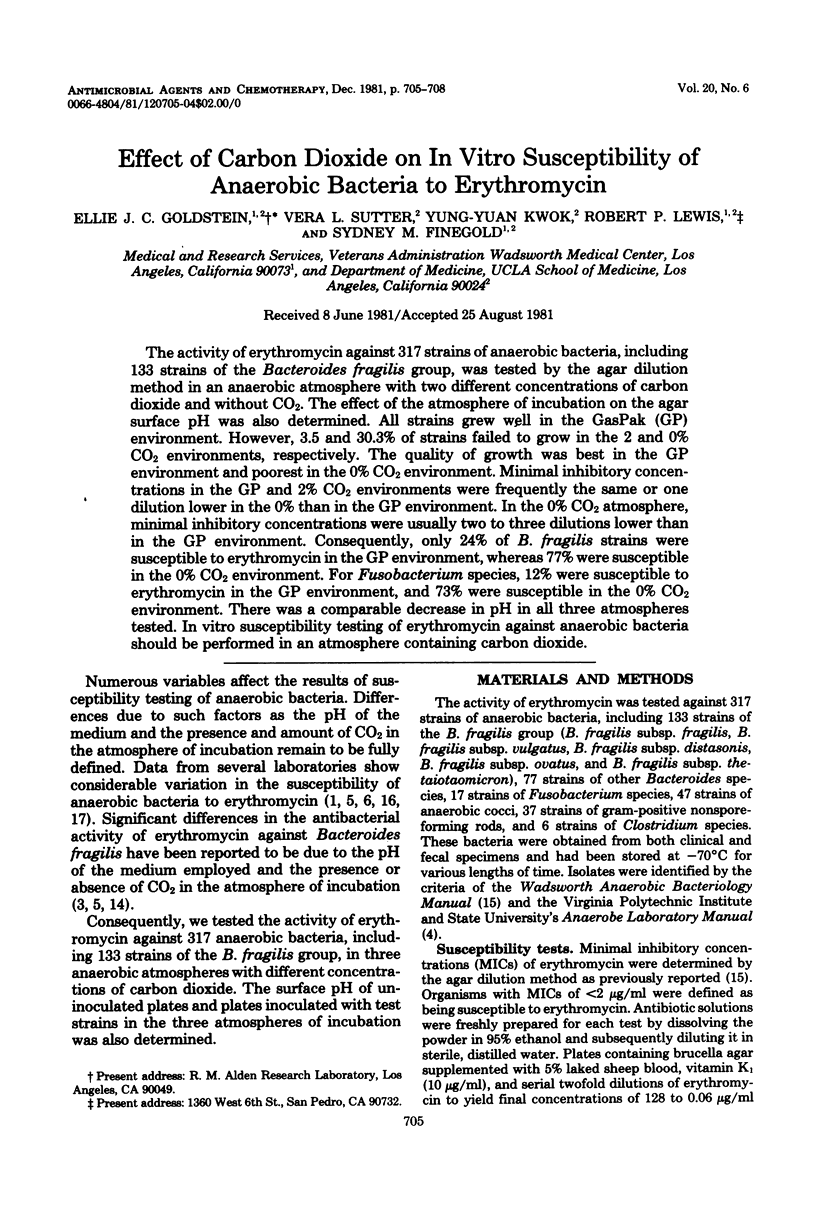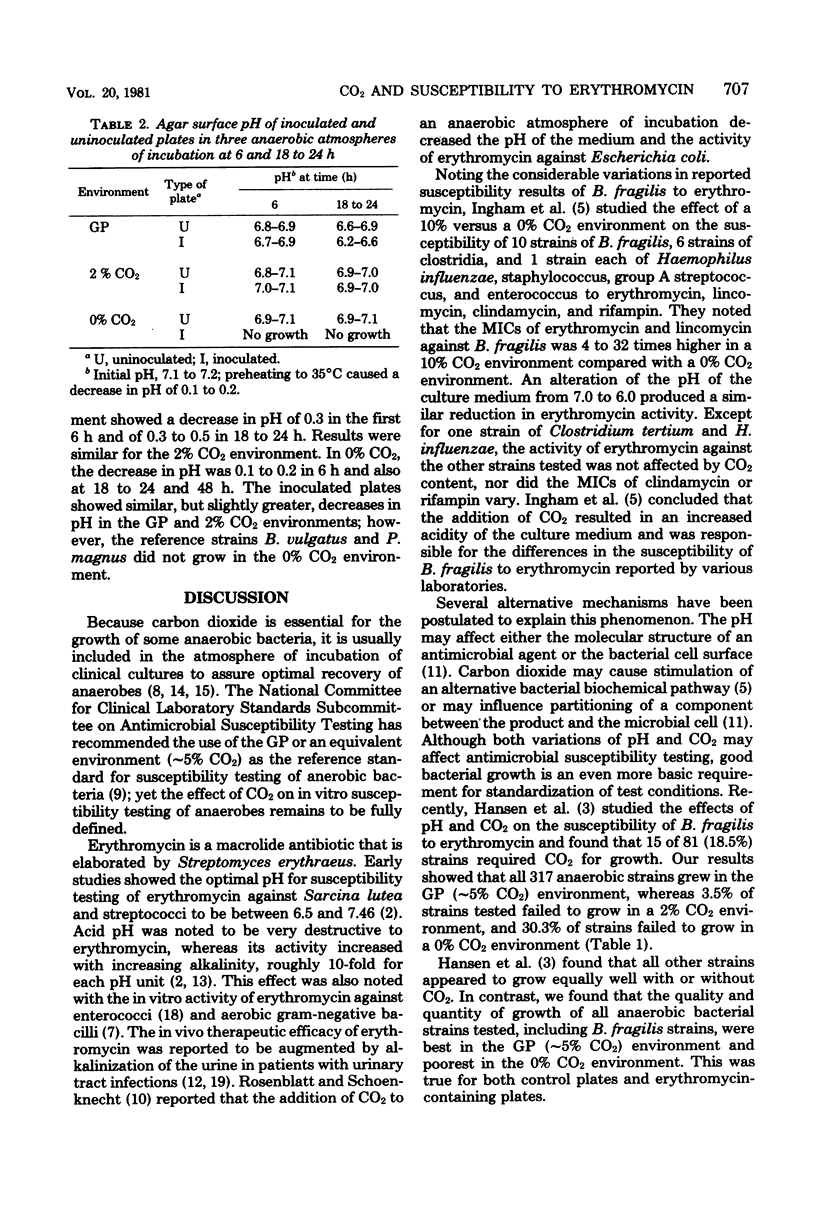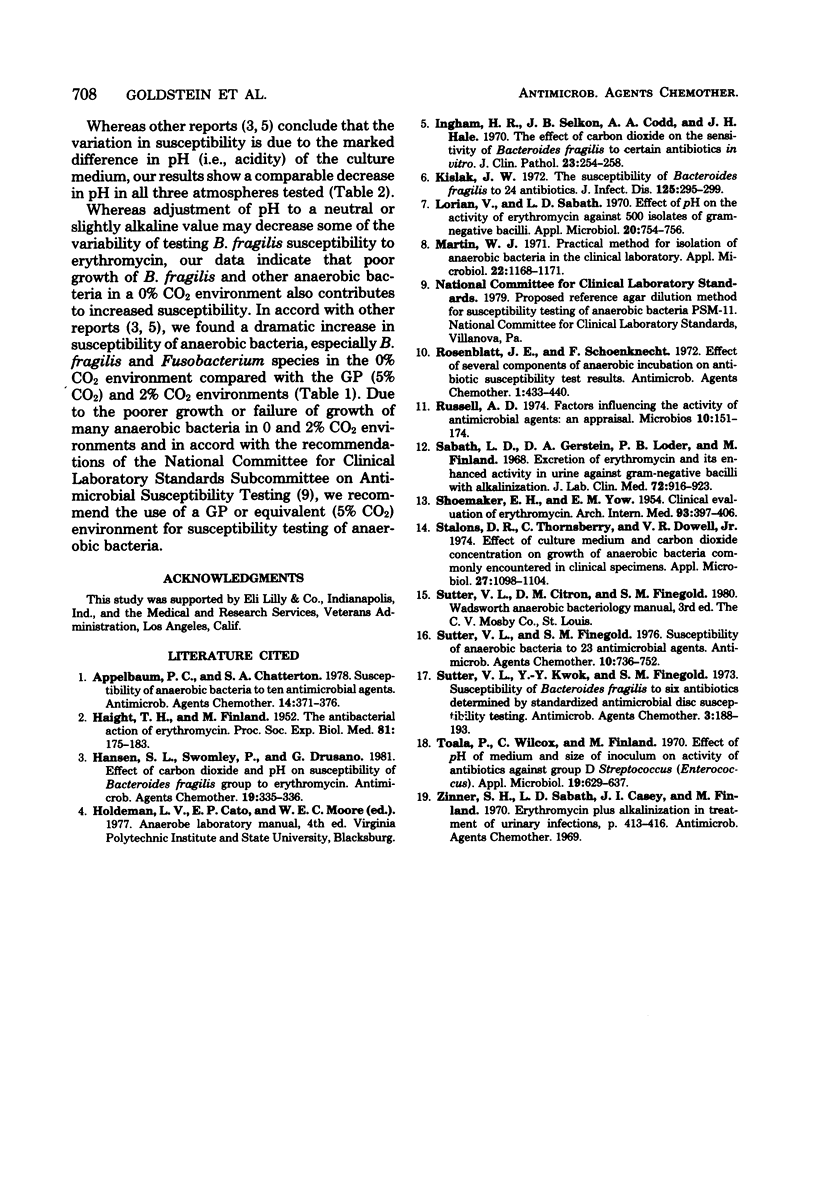Abstract
The activity of erythromycin against 317 strains of anaerobic bacteria, including 133 strains of the Bacteroides fragilis group, was tested by the agar dilution method in an anaerobic atmosphere with two different concentrations of carbon dioxide and without CO2. The effect of the atmosphere of incubation on the agar surface pH was also determined. All strains grew well in the GasPak (GP) environment. However, 3.5 and 30.3% of strains failed to grow in the 2 and 0% CO2 environments, respectively. The quality of growth was best in the GP environment and poorest in the 0% CO2 environment. Minimal inhibitory concentrations in the GP and 2% CO2 environments were frequently the same or one dilution lower in the 0% than in the GP environment. In the 0% CO2 atmosphere, minimal inhibitory concentrations were usually two to three dilutions lower than in the GP environment. Consequently, only 24% of B. fragilis strains were susceptible to erythromycin in the GP environment, whereas 77% were susceptible in the 0% CO2 environment. For Fusobacterium species, 12% were susceptible to erythromycin in the GP environment, and 73% were susceptible in the 0% CO2 environment. There was a comparable decrease in pH in all three atmospheres tested. In vitro susceptibility testing of erythromycin against anaerobic bacteria should be performed in an atmosphere containing carbon dioxide.
Full text
PDF



Selected References
These references are in PubMed. This may not be the complete list of references from this article.
- Appelbaum P. C., Chatterton S. A. Susceptibility of anaerobic bacteria to ten antimicrobial agents. Antimicrob Agents Chemother. 1978 Sep;14(3):371–376. doi: 10.1128/aac.14.3.371. [DOI] [PMC free article] [PubMed] [Google Scholar]
- HAIGHT T. H., FINLAND M. The antibacterial action of erythromycin. Proc Soc Exp Biol Med. 1952 Oct;81(1):175–183. doi: 10.3181/00379727-81-19815. [DOI] [PubMed] [Google Scholar]
- Hansen S. L., Swomley P., Drusano G. Effect of carbon dioxide and pH on susceptibility of Bacteroides fragilis group to erythromycin. Antimicrob Agents Chemother. 1981 Feb;19(2):335–336. doi: 10.1128/aac.19.2.335. [DOI] [PMC free article] [PubMed] [Google Scholar]
- Ingham H. R., Selkon J. B., Codd A. A., Hale J. H. The effect of carbon dioxide on the sensitivity of Bacteroides fragilis to certain antibiotics in vitro. J Clin Pathol. 1970 Apr;23(3):254–258. doi: 10.1136/jcp.23.3.254. [DOI] [PMC free article] [PubMed] [Google Scholar]
- Kislak J. W. The susceptibility of Bacteroides fragilis to 24 antibiotics. J Infect Dis. 1972 Mar;125(3):295–299. doi: 10.1093/infdis/125.3.295. [DOI] [PubMed] [Google Scholar]
- Lorian V., Sabath L. D. Effect of pH on the activity of erythromycin against 500 isolates of gram-negative bacilli. Appl Microbiol. 1970 Nov;20(5):754–756. doi: 10.1128/am.20.5.754-756.1970. [DOI] [PMC free article] [PubMed] [Google Scholar]
- Martin W. J. Practical method for isolation of anerobic bacteria in the clinical laboratory. Appl Microbiol. 1971 Dec;22(6):1168–1171. doi: 10.1128/am.22.6.1168-1171.1971. [DOI] [PMC free article] [PubMed] [Google Scholar]
- Rosenblatt J. E., Schoenknecht F. Effect of several components of anaerobic incubation on antibiotic susceptibility test results. Antimicrob Agents Chemother. 1972 May;1(5):433–440. doi: 10.1128/aac.1.5.433. [DOI] [PMC free article] [PubMed] [Google Scholar]
- Russell A. D. Factors influencing the activity of antimicrobial agents: an appraisal. Microbios. 1974 Apr;10(38):151–174. [PubMed] [Google Scholar]
- SHOEMAKER E. H., YOW E. M. Clinical evaluation of erythromycin. AMA Arch Intern Med. 1954 Mar;93(3):397–406. doi: 10.1001/archinte.1954.00240270083008. [DOI] [PubMed] [Google Scholar]
- Sabath L. D., Gerstein D. A., Loder P. B., Finland M. Excretion of erythromycin and its enhanced activity in urine against gram-negative bacilli with alkalinization. J Lab Clin Med. 1968 Dec;72(6):916–923. [PubMed] [Google Scholar]
- Stalons D. R., Thornsberry C., Dowell V. R., Jr Effect of culture medium and carbon dioxide concentration on growth of anaerobic bacteria commonly encountered in clinical specimens. Appl Microbiol. 1974 Jun;27(6):1098–1104. doi: 10.1128/am.27.6.1098-1104.1974. [DOI] [PMC free article] [PubMed] [Google Scholar]
- Sutter V. L., Finegold S. M. Susceptibility of anaerobic bacteria to 23 antimicrobial agents. Antimicrob Agents Chemother. 1976 Oct;10(4):736–752. doi: 10.1128/aac.10.4.736. [DOI] [PMC free article] [PubMed] [Google Scholar]
- Sutter V. L., Kwok Y., Finegold S. M. Susceptibility of Bacteroides fragilis to six antibiotics determined by standardized antimicrobial disc susceptibility testing. Antimicrob Agents Chemother. 1973 Feb;3(2):188–193. doi: 10.1128/aac.3.2.188. [DOI] [PMC free article] [PubMed] [Google Scholar]
- Toala P., Wilcox C., Finland M. Effect of pH of medium and size of inoculum on activity of antibiotics against group D Streptococcus (Enterococcus). Appl Microbiol. 1970 Apr;19(4):629–637. doi: 10.1128/am.19.4.629-637.1970. [DOI] [PMC free article] [PubMed] [Google Scholar]


